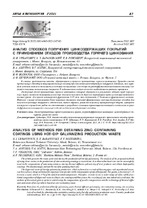| dc.contributor.author | Урбанович, Н. И. | |
| dc.contributor.author | Барановский, К. Э. | |
| dc.contributor.author | Розенберг, Е. В. | |
| dc.contributor.author | Ашуйко, В. А. | |
| dc.contributor.author | Матыс, В. Г. | |
| dc.contributor.author | Волосюк, В. Ф. | |
| dc.contributor.author | Печерский, А. Ф. | |
| dc.coverage.spatial | Минск | ru |
| dc.date.accessioned | 2021-07-02T07:21:20Z | |
| dc.date.available | 2021-07-02T07:21:20Z | |
| dc.date.issued | 2021 | |
| dc.identifier.citation | Анализ способов получения цинксодержащих покрытий с применением отходов производства горячего цинкования = Analysis of methods for obtaining zinc-containing coatings using hot-dip galvanizing production waste / Н. И. Урбанович [и др.] // Литье и металлургия. – 2021. – № 2. – С. 87-93. | ru |
| dc.identifier.uri | https://rep.bntu.by/handle/data/95927 | |
| dc.description.abstract | В статье представлены отходы, образующиеся в процессе производства горячего цинкования. Проведен анализ предлагаемых способов использования данных отходов при получении цинксодержащих покрытий. Показано, что гартцинк успешно можно использовать в составах насыщающих смесей при термодиффузионном цинковании стальных изделий и получать качественные покрытия. К недостаткам следует отнести необходимость размола гартцинка. Дисперсный отход производства горячего цинкования, который образуется в результате обдувки труб перегретым паром, можно использовать в качестве дешевого заменителя дорогого порошкового цинка в составах цинкнаполненных красок. Для красок используется фракция от 2–15 мкм, что составляет 27 % от всего фракционного состава. Поэтому с целью использования более широкого диапазона значений фракционного состава дисперсных отходов для получения цинковых покрытий и обеспечения, таким образом, рециклинга цинка в промышленный оборот, авторами планируется проведение работ по оптимизации и разработке составов порошковых композиций и технологии термо- диффузионного насыщения стальных изделий на базе цинксодержащих отходов. | ru |
| dc.language.iso | ru | ru |
| dc.publisher | БНТУ | ru |
| dc.title | Анализ способов получения цинксодержащих покрытий с применением отходов производства горячего цинкования | ru |
| dc.title.alternative | Analysis of methods for obtaining zinc-containing coatings using hot-dip galvanizing production waste | ru |
| dc.type | Article | ru |
| dc.identifier.doi | 10.21122/1683‑6065‑2021‑2‑87‑93 | |
| local.description.annotation | The article presents the waste generated during the production of hot-dip galvanizing. The analysis of the proposed methods of using these wastes in the production of zinc-containing coatings is carried out. It is shown that hard zinc can be successfully used in the compositions of saturating mixtures during thermal diffusion galvanizing of steel products and obtain high-quality coatings. The disadvantages include the need for grinding hard zinc. The dispersed waste of hot-dip galvanizing production, which is formed as a result of blowing pipes with superheated steam, can be used as a cheap substitute for expensive zinc powder in the compositions of zinc-filled paints. For paints, a fraction of 2–15 microns is used, which is 27 % of the total fractional composition. Therefore, in order to use a wider range of values of the fractional composition of dispersed waste to obtain zinc coatings and thus ensure the recycling of zinc into industrial circulation, the authors of this article plan to optimize and develop the compositions of powder compositions and the technology of thermal diffusion saturation of steel products based on zinc-containing waste. | ru |

